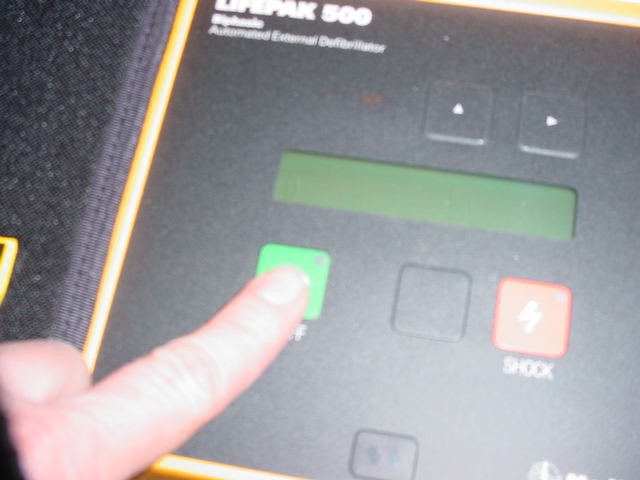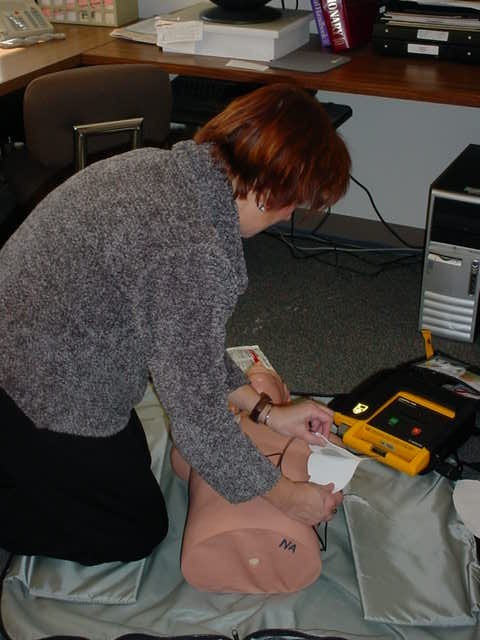-
AED/CPR Information
The purpose of this information is to keep the NA community informed and updated on Cardiopulmonary Resuscitation and using an AED. While it is our greatest hope that we will never have to use these procedures and equipment, we must also live by the credo "always prepared". If you can save a person's life, then the time and resources spent on this project are worth it.
AED Building Locations
Every building in the district has at least one AED, including the Baierl Center for Excellence and the Transportation Department. Posters are located throughout each building to identify specific locations. Be sure to make notice of these posters and locations so that you are "prepared!".
The Chain of Survival
- EARLY Access
- EARLY CPR
- EARLY Defibrillation
- EARLY Advanced Care
Remember, it takes only one person to start the chain and increase the person's chance of survival. You can be that person to make a difference.
CPR Adult and Older Child Child (1-8 years old) Infant (less than 1 year old) Victim is unresponsive Phone 911 Give two minutes of CPR, then phone 911 Give two minutes of CPR, then phone 911 Open the airway using the head tilt chin lift Open the airway using the head tilt chin lift Open the airway using the head tilt chin lift Open the airway using the head tilt chin lift Check for breathing - look, listen, and feel for 5-10 seconds Check for breathing - look, listen, and feel for 5-10 seconds Check for breathing - look, listen, and feel for 5-10 seconds Check for breathing - look, listen, and feel for 5-10 seconds If no circulation, provide chest compressions Find the center of the chest (using the nipple line). Place the heel of one hand on the sternum with the other hand on top; provide 30 compressions at least 1.5 to 2 inches deep. Find the center of the chest (using the nipple line). Use 1 or 2 hands providing 30 compressions ⅓ to ½ inch deep. Place index finger on sternum at nipple line. Using next two fingers, provide 30 compressions ⅓ to ½ inch deep. Compression Rate (timed for one minute if only doing compressions) 100 100 100 Compression to ventilation rate 30:2 30:2 30:2 To Relieve Choking Abdominal Thrusts (Heimlich Maneuver) Abdominal Thrusts (Heimlich Maneuver) Back slaps and chest thrusts AED Use Adult and Older Child Child (1-8 years old) Infant (less than 1 year old) Turn the power on (or open the case) Use AED as soon as it arrives Use AED after 5 sets of 30 compressions and 2 breaths Not recommended for use on infants under one year of age Attach pad to the victim's bare chest Use Adult Pads Use Child Pads Allow the AED to check the heart rhythm Clear and Analyze Clear and Analyze Push the shock button if prompted by the AED Clear and Shock Clear and Shock Time from arrival of AED to first shock less than 90 seconds less than 90 seconds Performing Adult CPR with an Automatic External Defibrillator (AED)
Determine unresponsiveness. If unresponsive:
- If you are alone, phone 911, get the AED, and return to the victim.
- If you are not alone, scream for help, direct someone to call 911, and direct another to get the AED.
A - Open the airway with the head tilt - chin lift.

B - Check for Movement - Place your face, cheek side down, next to the victims face. Your eyes should be looking towards the victim's chest.
- Look to see if the chest rises
- Listen for air movement
- Feel for breaths on your cheek
C - Circulation - Remove clothing from the front of the chest and perform chest compressions.

- Compress lower half of the sternum at the nipple line 1.5 to 2 inches
- Compress at a rate of about 100 times per minute
- Give 30 compressions to two rescue breaths
- After five cycles or about two minutes, check for signs of circulation
D. Defibrillate - When the AED is brought to the site, power on the AED.

Attach the AED pads to the victim's bare chest. Follow the electrode diagram for placement location.

Follow AED instructions. "Clear" the victim while the AED checks the rhythm. If there is a shockable rhythm, "clear" the victim and push the shock button if the AED tells you to. Be certain to do a visual inspection around the victim to make certain all bystanders are clear before pressing the shock button.

If no shock is advised by the AED, continue CPR until rescue personnel arrive. If victim has a pulse and is breathing, place him/her in the recovery position and leave the electrodes in place.
Additional Links
Select a School...
Select a School
- Bradford Woods Elementary School
- Franklin Elementary School
- Hosack Elementary School
- Ingomar Elementary School
- Marshall Elementary School
- McKnight Elementary School
- Peebles Elementary School
- Carson Middle School
- Ingomar Middle School
- Marshall Middle School
- NA Intermediate High School
- NA Senior High School
- NA Cyber Academy


